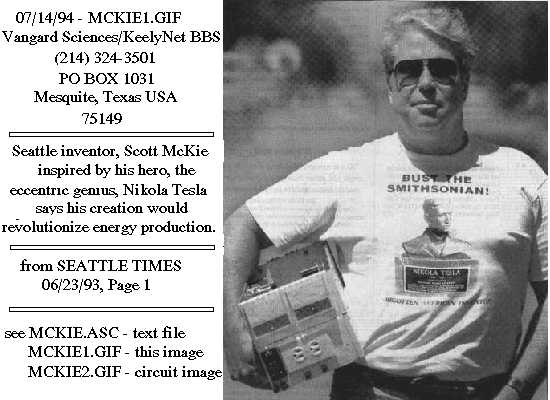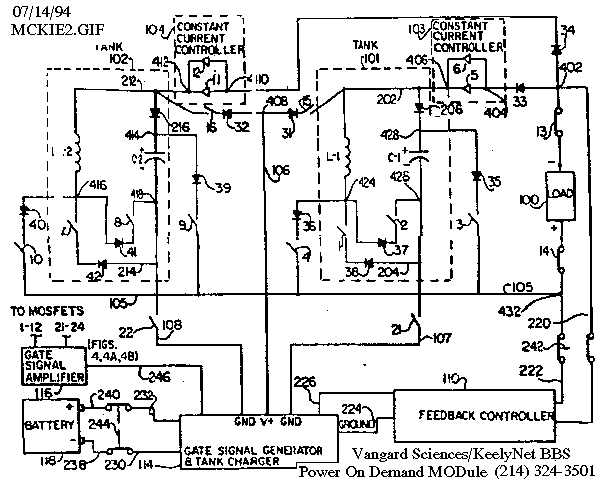The PODMOD of Scott McKie - 06/02/94
FROM SEATTLE TIMES - June 23, 1993
The McKie PODMOD
If he's right,the world will hear of this man
BY TERRY McDERMOTT - Seattle Times staff reporter
Manufacture a power generator that will perpetually produce more energy than is fed into it; manufacture, in other words, perpetual- motion machines that will replace the world's electric power grid by the turn of the century and internal-combustion engines somewhat thereafter.This raises at least one obvious question. Is McKie nuts? Asked to evaluate someone who has spent the better part of a dozen years single-mindedly pursuing an idea most people find ludicrous, Blake Andersen, a local psychologist, said that generically speaking, lots of people do lots of weird things. We live on a continuum of odd behavior. "You can't place a value judgment on whether it's functional or dysfunctional. It's results-oriented," Andersen said. "The degree of dysfunctionality depends on the environment and the results." Andersen then began to explain some symptoms of obsessive behavior but, in midsentence, interrupted himself to ask: "Does it work?" Engineers by their nature are not off-the-wall people and, although McKie admits going through several jobs and bank accounts in service of his idea, he is in other ways a very practical man. Witness the collection of financiers, planners, engineers and marketing people he has collected around himself. If he is a mad scientist, he's one with a business plan and a $10 million line of credit. But he is also a devotee of Nikola Tesla, a turn-of-the-century Serbian- American inventor, who, by all accounts, was a mad scientist with countless phobias and odd personal habits. His psyche, wrote Margaret Cheney, a biographer, was a "festival of neuroses." He swore, for example, he could hear a fly land on a table. He threw kisses to pigeons. He held lightning in his hands. He had an obsessive fear of germs and required precisely 18 linen napkins be set on his dining table so he could clean and polish his silverware every night before eating. He felt compelled to walk around the entire block where his Manhattan laboratory was located three times before entering its door. At the height of his celebrity, he hobnobbed with Mark Twain, J. Pierpont Morgan and the Vanderbilts and was regarded as one of the greatest and most important scientists in the world, an archrival of Thomas Edison. Edison took the competition so seriously he waged a fierce disinformation campaign against alternating current, which Tesla promoted as the best means of generating electricity in large amounts. Edison favored direct current, the status quo. Edison derided alternating current as dangerous. He hired a man to go around the country electrocuting small animals with alternating current just to prove its dangers. He also promoted the first execution of a criminal by electrocution for the same reason. (The pitch was straightforward: If alternating current can kill criminals, do you really want it in your kitchen?) Tesla ultimately won out and virtually all the electric power used in the world today is generated and transmitted via descendants of Tesla's systems. In addition to the alternating-current motor, Tesla also invented wireless communication--that is, radio-- although the Italian Guglielmo Marconi was falsely credited and most general reference books still reflect this. Partly this was caused by Tesla's compulsive secretiveness and his habit of conceiving an invention in his head, then going on to his next project without bothering to actually build or even make a written record of the thing. Without such physical evidence or even clear explanations, it is hard to know exactly what Tesla was talking about much of the time. Scientists still puzzle over how he achieved some of the things he did. This has helped obscure Tesla's place in history. Now, although references to him litter diverse segments of the scientific literature, his accomplishments are largely forgotten except among a group of equally diverse adherents who have a zealous devotion to his ideas. Resurrecting 'resonance' theory McKie is a promoter of one particular idea of Tesla's, the notion that the power in an electric circuit can be amplified by a phenomenon known as resonance. Broadly stated, in a resonant circuit a small flow of electrons can cause a larger amount of electrons to move. This phenomenon was first discovered by Tesla and by now is well understood. Vanguard Notes In fact, the phenomenon of tapping energy from resonance was first discovered by John Keely and PUBLICLY documented in the book "Keely and his Discoveries" by Clara Bloomfield Moore in 1893. The principle was discovered even earlier by Keely yet this is the most accessible document of it. To quote:
The time is probably near when these finer forces will be employed universally. Everybody knows that a note struck upon an instrument will produce sound in a correspondingly attuned instrument in its vicinity. If connected with a tuning fork, it will produce a corresponding sound in the latter; and IF CONNECTED WITH A THOUSAND SUCH TUNING FORKS, IT WILL MAKE ALL THE THOUSAND SOUND, AND PRODUCE A NOISE FAR GREATER THAN THE ORIGINAL SOUND, WITHOUT THE LATTER BECOMING ANY WEAKER FOR IT. Here, then, is the AUGMENTATION OR MULTIPLICATION OF POWER. If we had any means to TRANSFORM SOUND again into MECHANICAL MOTION, we would have a THOUSANDFOLD MULTIPLICATION OF MECHANICAL MOTION. (Vanguard Note - This is apparently a pumping of the neutral centres of the mass to cause a release of the now current ZERO POINT ENERGY.) It would be presumptuous to say that it will not be as easy for the scientists of the future to transform sound into mechanical motion, as it is for the scientist of the present to transform heat into electricity. Perhaps Mr. Keely has already solved the problem. There is a fair prospect that in the very near future, we shall have, in his ethereal force, a power far surpassing that of steam or electricity. Nor does the idea seem to be Utopian if we remember that modern science heretofore only knew the law of the conservation of energy; while to the scientist of the future the law of the AUGMENTATION OF ENERGY will be unveiled. As the age which has passed away has been the age of steam, the coming era will be the age of induction. There will be a universal rising up of LOWER VIBRATIONS INTO HIGHER VIBRATIONS, in the realm of motion. Mr. Keely will, perhaps, TRANSFORM SOUND INTO MECHANICAL MOTION by applying the LAW OF AUGMENTATION AND MULTIPLICATION OF FORCE." (*** The principle follows with all forms of energy, not simply acoustic. Just wanted to set the record straight, there are STILL many misconceptions in the F/E field, especially with regard to Tesla. Many people have never heard of Keely and others who have, simply brush him off in favor of the more public and easier to understand Tesla. I think the term is 'afficionados'....>>> Jerry)"Boilerplate stuff," McKie calls it. "The knowledge is very old and had gotten lost," he said. "I've just gone back and brought it up to '93 specs." The " '93 specs" consist of a device designed with two resonant tank circuits--so called because they are able to store an electrical charge-- operating alternately. The first circuit can be made to simultaneously charge the second and send electric current out for other uses. The circuits can then be switched so the second recharges the first while also sending current out for other uses. McKie thinks that if properly devised, the two circuits will produce more power than the total amount of power it took to set them in motion. Going "over unity," this is called. He thinks, in fact, the power can be amplified many thousands of times and the device can be disconnected from the power source that started it and continue running. McKie thinks such a system could operate indefinitely. "In the field of electronics that sends them ballistic," he said. Next step: POD Mods in Ephrata When you talk to McKie about the apparent impossibility of what he is trying to do, he invariably thinks you're talking about marketing the end products, never for a moment questioning whether any such products will ever exist. McKie has so little doubt his invention will work he is already making plans to manufacture boxcar-sized versions of it -- power on demand modules, or POD Mods, he calls them --in Ephrata, Grant County. He has signed an agreement with a California investor for $10 million in start-up financing. He's already planning an electric hydroplane to advertise his company. His single-mindedness is so complete he hardly even notices that his house is in foreclosure. He says things like, "If investors don't come forward here in the Northwest, I'll be forced to take the project overseas and, if it's funded there, they'll get to use it first." McKie first achieved the over-unity effect accidentally in 1982 when he was working on a wind-turbine design for Bonneville Power. Trying to figure out what happened, and why, has shaped most of his life since. He duplicated the effect with a different electrical generator in 1984 and has, in some sense, been trying to do it again ever since. He received a U.S. patent for the idea last year, constructed a working model, took that model apart and is now trying to convert the whole thing to solid-state electronics. The device he is now building, on a workbench the size of an espresso cart in his garage, is about as unprepossessing as you can get. It is a cardboard box sparely furnished with circuit boards and voltage meters. The whole thing is approximately a foot square, about the size of a bread box.


Inventor - Scott McKie
Filed - August 9, 1991 References Cited 3,387,201 6/1968 - Greenberg et al
3,886,429 5/1975 - Maillard et al
4,319,315 3/1982 - Keeney, Jr. et al
4,488,214 12/1984 - Chambers
4,513,226 4/1985 - Josephson
4,542,440 9/1985 - Chetty et al
4,628,284 12/1986 - Bruning
4,709,323 11/1987 - Lien
4,748,311 5/1988 - Thomas et al ABSTRACT The present invention provides a power supply for supplying electrical power to a load. The power supply includes first and second tank circuits having a common resonant frequency, and functions repetitively in two "major periods." In the first major period, the first tank is disconnected from powering the load and the second tank supplies power to the load while charging the first tank. In the second major period, the second tank is disconnected from powering the load, and the first tank supplies power to the load while charging the second tank. The tank circuits are arranged with constant current controllers and switches to function so that the major periods each include first and second minor "intervals." The first minor interval of the first major period defines a time during which the second tanks' capacitor is providing power to the load AND IS charging the first tank circuit; the second minor interval of the first major period defines a time during which the second tank's inductor is charging the first tank circuit and providing power to the load. During the second major period's two minor intervals, the tank circuits perform functions identical to those performed in the first two minor intervals.